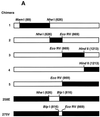Amino acid residues contributing to the substrate specificity of the influenza A virus neuraminidase
- PMID: 10400772
- PMCID: PMC112759
- DOI: 10.1128/JVI.73.8.6743-6751.1999
Amino acid residues contributing to the substrate specificity of the influenza A virus neuraminidase
Abstract
Influenza A viruses possess two glycoprotein spikes on the virion surface: hemagglutinin (HA), which binds to oligosaccharides containing terminal sialic acid, and neuraminidase (NA), which removes terminal sialic acid from oligosaccharides. Hence, the interplay between these receptor-binding and receptor-destroying functions assumes major importance in viral replication. In contrast to the well-characterized role of HA in host range restriction of influenza viruses, there is only limited information on the role of NA substrate specificity in viral replication among different animal species. We therefore investigated the substrate specificities of NA for linkages between N-acetyl sialic acid and galactose (NeuAcalpha2-3Gal and NeuAcalpha2-6Gal) and for different molecular species of sialic acids (N-acetyl and N-glycolyl sialic acids) in influenza A viruses isolated from human, avian, and pig hosts. Substrate specificity assays showed that all viruses had similar specificities for NeuAcalpha2-3Gal, while the activities for NeuAcalpha2-6Gal ranged from marginal, as represented by avian and early N2 human viruses, to high (although only one-third the activity for NeuAcalpha2-3Gal), as represented by swine and more recent N2 human viruses. Using site-specific mutagenesis, we identified in the earliest human virus with a detectable increase in NeuAcalpha2-6Gal specificity a change at position 275 (from isoleucine to valine) that enhanced the specificity for this substrate. Valine at position 275 was maintained in all later human viruses as well as swine viruses. A similar examination of N-glycolylneuraminic acid (NeuGc) specificity showed that avian viruses and most human viruses had low to moderate activity for this substrate, with the exception of most human viruses isolated between 1967 and 1969, whose NeuGc specificity was as high as that of swine viruses. The amino acid at position 431 was found to determine the level of NeuGc specificity of NA: lysine conferred high NeuGc specificity, while proline, glutamine, and glutamic acid were associated with lower NeuGc specificity. Both residues 275 and 431 lie close to the enzymatic active site but are not directly involved in the reaction mechanism. This finding suggests that the adaptation of NA to different substrates occurs by a mechanism of amino acid substitutions that subtly alter the conformation of NA in and around the active site to facilitate the binding of different species of sialic acid.
Figures








Similar articles
-
Amino acids responsible for the absolute sialidase activity of the influenza A virus neuraminidase: relationship to growth in the duck intestine.J Virol. 2001 Dec;75(23):11773-80. doi: 10.1128/JVI.75.23.11773-11780.2001. J Virol. 2001. PMID: 11689658 Free PMC article.
-
Substrate Binding by the Second Sialic Acid-Binding Site of Influenza A Virus N1 Neuraminidase Contributes to Enzymatic Activity.J Virol. 2018 Sep 26;92(20):e01243-18. doi: 10.1128/JVI.01243-18. Print 2018 Oct 15. J Virol. 2018. PMID: 30089692 Free PMC article.
-
Complex N-glycans are important for interspecies transmission of H7 influenza A viruses.J Virol. 2024 Apr 16;98(4):e0194123. doi: 10.1128/jvi.01941-23. Epub 2024 Mar 12. J Virol. 2024. PMID: 38470143 Free PMC article.
-
[Role of Glycoconjugates and Mammalian Sialidases Involved in Viral Infection and Neural Function].Yakugaku Zasshi. 2022;142(4):381-388. doi: 10.1248/yakushi.21-00212. Yakugaku Zasshi. 2022. PMID: 35370194 Review. Japanese.
-
Influenza hemagglutinin and neuraminidase membrane glycoproteins.J Biol Chem. 2010 Sep 10;285(37):28403-9. doi: 10.1074/jbc.R110.129809. Epub 2010 Jun 10. J Biol Chem. 2010. PMID: 20538598 Free PMC article. Review.
Cited by
-
Acquisition of Innate Inhibitor Resistance and Mammalian Pathogenicity During Egg Adaptation by the H9N2 Avian Influenza Virus.Front Microbiol. 2018 Aug 21;9:1939. doi: 10.3389/fmicb.2018.01939. eCollection 2018. Front Microbiol. 2018. PMID: 30186261 Free PMC article.
-
N-glycolylneuraminic acid on human epithelial cells prevents entry of influenza A viruses that possess N-glycolylneuraminic acid binding ability.J Virol. 2014 Aug;88(15):8445-56. doi: 10.1128/JVI.00716-14. Epub 2014 May 14. J Virol. 2014. PMID: 24829344 Free PMC article.
-
Ferrets exclusively synthesize Neu5Ac and express naturally humanized influenza A virus receptors.Nat Commun. 2014 Dec 17;5:5750. doi: 10.1038/ncomms6750. Nat Commun. 2014. PMID: 25517696 Free PMC article.
-
Amino acids responsible for the absolute sialidase activity of the influenza A virus neuraminidase: relationship to growth in the duck intestine.J Virol. 2001 Dec;75(23):11773-80. doi: 10.1128/JVI.75.23.11773-11780.2001. J Virol. 2001. PMID: 11689658 Free PMC article.
-
Kinetic analysis of the influenza A virus HA/NA balance reveals contribution of NA to virus-receptor binding and NA-dependent rolling on receptor-containing surfaces.PLoS Pathog. 2018 Aug 13;14(8):e1007233. doi: 10.1371/journal.ppat.1007233. eCollection 2018 Aug. PLoS Pathog. 2018. PMID: 30102740 Free PMC article.
References
-
- Baum L G, Paulson J C. The N2 neuraminidase of human influenza virus has acquired a substrate specificity complementary to the hemagglutinin receptor specificity. Virology. 1991;180:10–15. - PubMed
-
- Connor R J, Kawaoka Y, Webster R G, Paulson J C. Receptor specificity in human, avian and equine H2 and H3 influenza virus isolates. Virology. 1994;205:17–23. - PubMed
-
- Couceiro J N, Paulson J C, Baum L G. Influenza virus strains selectively recognize sialyloligosaccharides on human respiratory epithelium; the role of the host cell in selection of hemagglutinin receptor specificity. Virus Res. 1993;29:155–165. - PubMed
-
- Couceiro J N, Baum L G. Characterization of the hemagglutinin receptor specificity and neuraminidase substrate specificity of clinical isolates of human influenza A viruses. Mem Inst Oswaldo Cruz. 1994;89:587–591. - PubMed
Publication types
MeSH terms
Substances
LinkOut - more resources
Full Text Sources
Other Literature Sources

